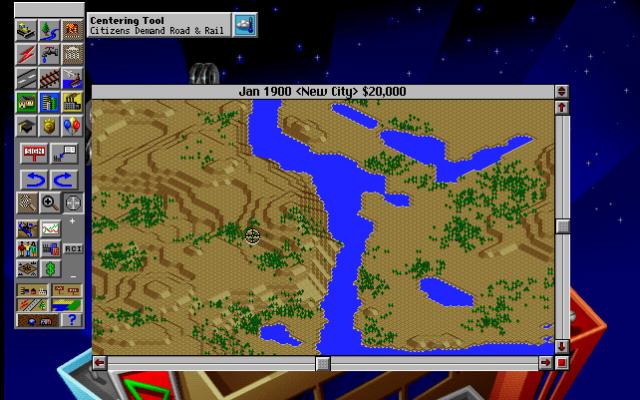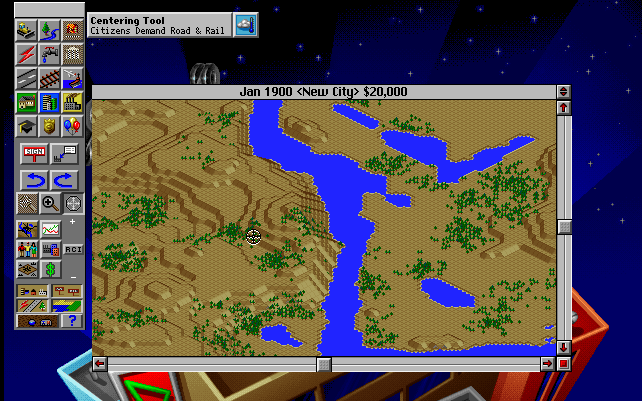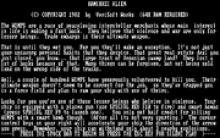SimCity 2000
Press Keyboard right side: Alt+Enter keys to switch to full screen game play, and Alt+Enter keys to return.
How to play SimCity 2000
Each game uses different controls, most DOS games use the keyboard arrows. Some will use the mouse.
SimCity 2000 Description
SimCity 2000 (SC2K) is a simulation/city building computer game and the second installment in the SimCity series. SC2K was first released by Maxis in 1993 for computers running the Apple Macintosh and MS-DOS operating systems. It was later re-released on a number of different platforms, including: Amiga (1994), Microsoft Windows (1995), SNES (1995), Sega Saturn (1995), PlayStation (1996), Nintendo 64 (1998), Pocket PC (1999) and Game Boy Advance (2003).
In 1995, SimCity 2000 won "Best Military or Strategy Computer Game" Origins Award.
The unexpected and enduring success of the original SimCity, combined with the relative lack of success with other "Sim" titles, finally motivated the development of a sequel. SC2K was a major extension of the concept; the view was now dimetric instead of overhead, land could have different elevations, and underground layers were introduced for water pipes and subways.
New types of facilities included prisons, schools, libraries, museums, marinas, zoos, stadiums, hospitals (although they appeared randomly on residential blocks in the first SimCity, they could not be built by player) and arcologies. Players could build highways, roads, bus depots, railway tracks, subways, train depots and zone land for seaports and airports. There are a total of nine varieties of power plants in SC2K, including coal, natural gas, wind turbines, hydroelectric dams (which can only be placed on waterfall tiles) and the futuristic fusion power and satellite microwave plant. Most types of power plants have a limited life span and must be rebuilt periodically.
The budget and finance controls are also much more elaborate — tax rates can be set individually for residential, commercial and industrial zones. Enacting city ordinances and connecting to neighbouring cities became possible.
Another new addition in SC2K is the query tool. Using the query tool on tiles reveals information such as structure name and type, altitude, and land value. Certain tiles also display additional information; power plants, for example, display the percentage of power being consumed when queried, and querying roads displays the amount of traffic on that tile. Querying a library and selecting 'Ruminate' displays an essay written by Neil Gaiman.
Graphics were added for buildings under construction in the residential, commercial, and industrial zones, as well as darkened buildings depicting abandoned buildings as a result of urban decay.
News comes in the form of several pre-written newspaper articles with variable names that could either be called up immediately or could be subscribed to on a yearly basis. The newspaper option provided many humorous stories as well as relevant ones, such as new technology, warnings about ageing power plant, recent disasters and opinion polls (highlighting city problems). SimCity 2000 is the only game in the entire series to have this feature, though newer versions have a news ticker. The newspapers had random titles (Times, Post, Herald, etc.), and prices based on the simulated year. Certain newspapers have a special monthly humor advice column by "Miss Sim."
Though there is no "true" victory sequence in SimCity 2000, the "exodus" is a close parallel. An "exodus" occurs during the year 2051 or later, when 250 or more Launch Arcologies are constructed; the following January each one "takes off" into space so that their inhabitants can form new civilizations on distant worlds (although the visual representation of scene consists of the Arcologies exploding in a manner similar to bulldozed buildings, one by one). This reduces the city's population to those who are not living in the Launch Arcologies, but it also opens wide areas for redevelopment and returns their construction cost to the city treasury. This is related to the event in SimEarth where all cities are moved into rocket-propelled domes that then leave to "found new worlds" (leaving no sentient life behind).
The game also included several playable "scenarios", in which the player must deal with a disaster (in most, but not all scenarios) and rebuild the city to meet a set of victory conditions. These were based in versions of real-life cities, and some were based on real events such as the 1991 Oakland firestorm, the 1989 Hurricane Hugo in Charleston, South Carolina, or dealing with the 1970s economic recession in Flint, Michigan - but also included more fanciful ones such as a "monster" destroying Hollywood in 2001. More scenarios added with the SCURK included a nuclear meltdown in Manhattan.
SimCity 2000 was the first sim game to feature the semi-nonsensical phrase "Reticulating Splines" listen, which means to make a network of splines. Will Wright has stated in an interview that the game does not actually reticulate splines when generating terrain, and he just inserted the phrase because it "sounded cool". The phrase has since been featured in SimCopter, SimCity 4 and The Sims.

SimCity 2000 - additional information















